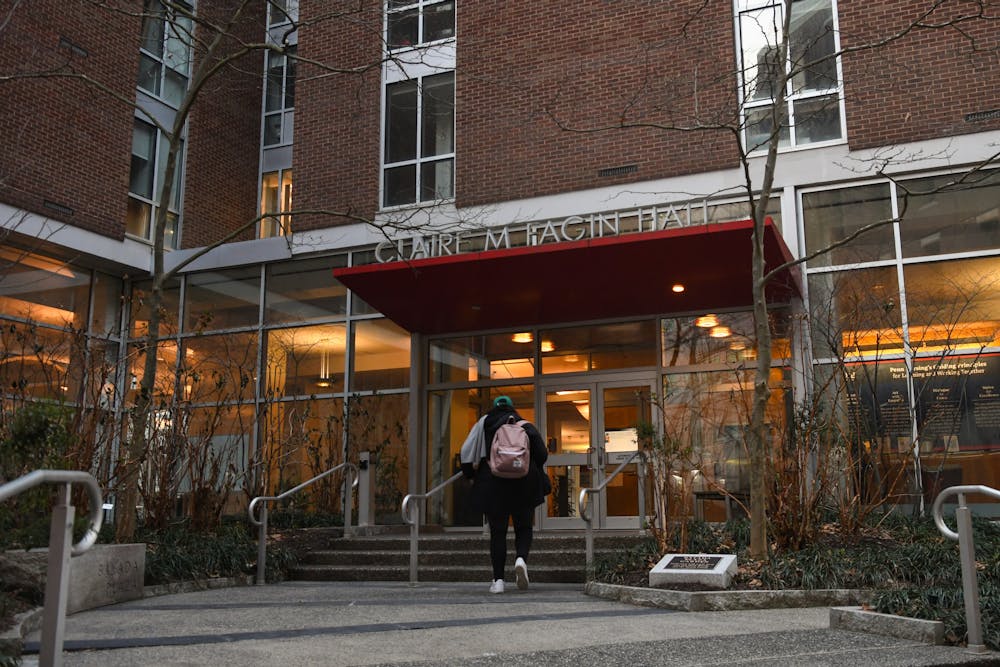
Penn's School of Nursing is located in Claire M. Fagin Hall at 418 Curie Blvd.
Credit: Anna VazhaeparambilAll undergraduate students in Penn's School of Nursing partake in clinical rotations — opportunities for them to gain experience in a hospital environment and apply skills learned in the classroom.
Clinical rotations, which begin in students' sophomore years, comprise one aspect of the Nursing School's graduation requirements. The Daily Pennsylvanian spoke with undergraduate Nursing students who described mixed experiences participating in clinical rotations, detailing the benefits and drawbacks of balancing clinicals with both academic and social commitments.
During clinical rotations, each Nursing student is paired with a nurse who accompanies them for the day.
Nursing junior Emily Milgrim said that students' responsibilities during the day may include taking care of patients that their nurse is assigned to and assisting other nurses on the floor with their day-to-day tasks. She added that, for students working on the labor and delivery floor, this could include grabbing cleaning supplies, coaching mothers through the childbirth process, and giving Vitamin K shots to infants.
Nursing sophomore Ellie Mayers added that students are expected to perform a daily physical assessment on patients and take their vital signs three times a day.
Nursing senior Brandon Lara said that he finds clinical experiences beneficial, citing students' abilities to learn necessary skills such as taking vitals, changing a patient, and flipping patients onto a different side — which allow them to be as prepared as possible when they begin working in a hospital.
“In my experience, it’s really good because you’re almost exactly doing the job that the nurses have to do,” Lara said.
Mayers added that some students prefer clinical rotations to learning in a classroom setting.
“It’s a much more hands-on learning experience," Mayers said. "I love the feeling when things start to all make sense, such as why we are giving this particular [medication] to a patient or why their symptoms are manifesting in such ways.”
Several students told the DP that, while they appreciate the importance and value of clinical rotations, clinicals are a large time commitment — especially when taking other classes. Most clinicals run from about 7 a.m. to 7 p.m., therefore taking up the whole day.
Mayers said that participating in clinicals can make it difficult to balance clinical work with other school work, extracurriculars, and social life.
She added that participating in clinicals can be disorienting when “most people around you have traditional college schedules and do not have to wake up super early to complete their coursework.”
“It’s hard to be a regular undergraduate and have this alter-ego that you have to adopt every week. We sometimes go to bed anxious the night before we have to wake up at 5 a.m. for a clinical,” Milgrim said.
Lara echoed Mayers and Milgrim's points, adding that the schedule for clinicals is "very rigid."
“We don't really have much time, at least the way the schedule’s constructed," Lara said. “It’s been very stressful, in terms of managing clinical rotations, as well as balancing a personal life. But, that’s nursing school.”
The students mentioned that one of the benefits of working in a Penn-affiliated hospital — as many students on clinical rotations do — is that the staff gives substantial autonomy and learning opportunities to students.
“Anytime that I was on the [postpartum] floor, they would call up me or some of my peers, and they would be like, ‘Look, we have an availability for you guys to help out,’” Lara said. “That's really what I love about Penn Nursing — anytime the Nursing students are able to help, they’re sought out, especially on the floor.”
Milgrim echoed this sentiment, saying that if there is a certain diagnosis, machine, or medication that they want students to see, they may rotate students there throughout the day.
“For example, if you’re learning about tracheostomies, they might put you with a tracheostomy patient for a few hours,” Milgrim said.
Mayers told the DP that clinicals can be a way to discover or further interests in a particular field. Mayers is currently in her women and infants rotation, a field she can see herself going into in the future.
“I want to ultimately do something in women’s health, particularly midwifery. I have been able to create connections between the information we learn in our courses and also deepen my understanding of the importance of nurses in this field,” Mayers said.
Nursing students complete the same series of clinical rotations: nursing of women and infants, nursing of young and middle aged adults, nursing of older adults, pediatric nursing, psychiatric nursing, and community and public health nursing. In the spring of their senior year, Nursing students choose a clinical site and take on a greater leadership role there.
While some students are excited about their hospital and rotation placement, others said that they are disappointed with their lack of autonomy in the process. Milgrim told the DP that clinical rotations and sites are not chosen by students in their sophomore or junior years, but rather automatically assigned — causing some students to be placed in unpreferable locations or types of care.
“Students are often disappointed with where they’re placed, that might not be something that they’re particularly interested in or a site that they can see themselves working with," she said. "But ultimately, it’s wherever the University has spots for students.”
Milgrim also shared excitement over her clinical rotation in her senior year — also called a leadership clinical.
“I’m looking forward to my leadership clinical because hopefully I’ll get my first choice and have some autonomy over where I am placed and what I am doing,” Milgrim said.
Nursing students are graded on critical thinking, clinical judgment, and completing care plans for the patients they are paired with, among other criteria, according to Mayers. She added that clinical assignments — which usually involve a full assessment of a patient, a full medication reconciliation, and a summary of their hospital stay — take place a few times each semester.
Lara said that students give a report at the end of each day on what they completed throughout their shift.
“At the end of the year, your instructor compiles a list of everything that you've done, and that instructor reflects on how they feel that you did throughout the semester,” Lara said.
The Daily Pennsylvanian is an independent, student-run newspaper. Please consider making a donation to support the coverage that shapes the University. Your generosity ensures a future of strong journalism at Penn.
Donate






